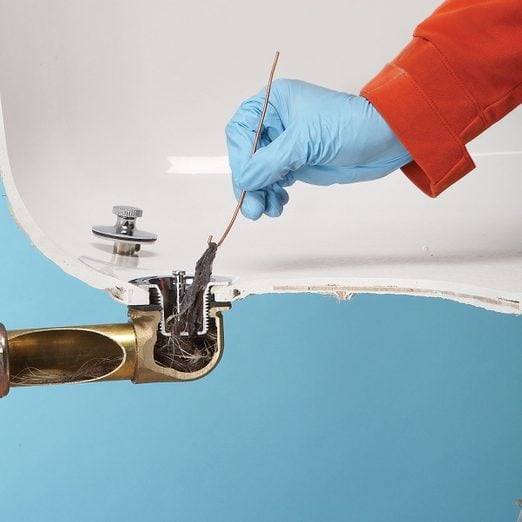How To Unclog a Bathtub Drain Without Chemicals
Updated: Mar. 27, 2024
Most bathtub drain clogs are caused by hair and soap scum. These tips will clear the hair and get the water flowing again.
An hour or less
Beginner
Less than $20
Introduction
My friends know I'm someone who likes to fix things. So even though I've retired from making professional house calls, I often get requests to clear stopped drains. Sink, bathtub and shower drains are usually easy to clear, and who doesn't like to bask in the glory of solving what seemed like an intractable problem?
Tyler Pittenger, the drain specialist for Maryland-based Service Force Plumbing, explained what typically causes bathtub drain clogs and why using chemicals is usually a poor option.
"Most tub and shower clogs are soap scum and hair," he says. "Many drain cleaners just 'wash the hair,' meaning the problem seems solved, but the old hair is still there waiting to collect more detritus and cause another backup."
It's better to do the job mechanically, using a plastic drain cleaning tool, auger, plunger or — in a pinch — a length of stiff wire.
Nine times out of 10, the clog is near the drain opening, where it's easy to reach. When it's deeper in the drain, some disassembly may be required to reach it. Here, Pittenger offers a word of caution: "If there are additional backed-up fixtures in you bathroom, like a backed up sink or toilet, the blockage is probably farther down the line and trying to address only a bathtub-drain clog won't affect it."
What if the bathtub has standing water?
You can usually break up a clog and get standing water to drain by using a plunger. Once all the water is gone, you can get to work removing the debris that caused the clog.
When should I call a pro?
More than one clogged bathroom fixture indicates a blockage deep in the waste line or sewer. If you can't clear the clog by plunging any of the drains or the toilet, you should call a plumber. There may be a systemic issue, like blocked vents or tree roots in the sewer, that needs professional diagnosis.
Tools Required
- Bucket
- Drain auger
- Drain plunger
- Gloves
- Jigsaw blade
- Needle-nose pliers
- Phillips and flat-head screwdrivers
- Plastic drain cleaning tool
- Towel or plastic bag
- Wire
Materials Required
- Heavy wire or coat hanger to bend into hook.
Project step-by-step (6)
Remove the drain stopper
Give yourself full access to the drain by removing the stopper. The procedure varies according to which type you have.
- Drop stopper: This has a prominent knob you lift and turn to open the drain. It comes with a set screw under the cap. To remove, it, unfasten the stopper from the set screw.
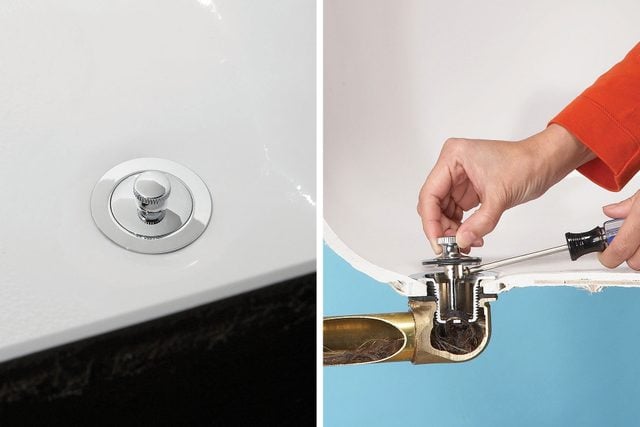
- Push/lock drain stopper: These lock and seal when you press down, and release when you push down a second time. Remove the stopper by holding onto the stem while unscrewing the cap. Because there isn’t much room for your fingers, I usually push a flat-head screwdriver against the stem to prevent it from turning.
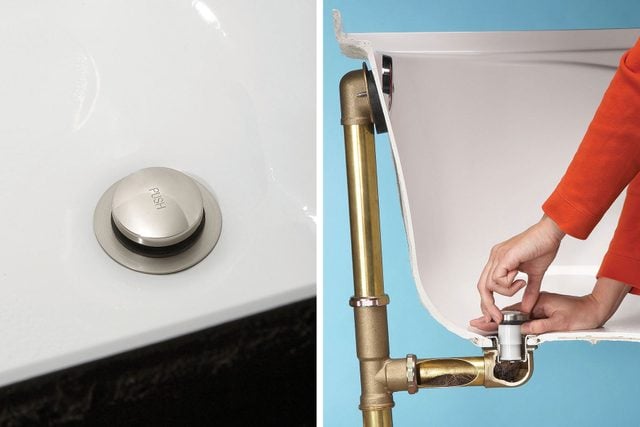
- Levered stopper: Many tubs, especially older ones, have a stopper inside the drain and overflow tube. Most have a lever on the overflow plate and a screen over the drain. Unscrew and remove the screen to open the drain, then unscrew the overflow plate and pull out the linkage.
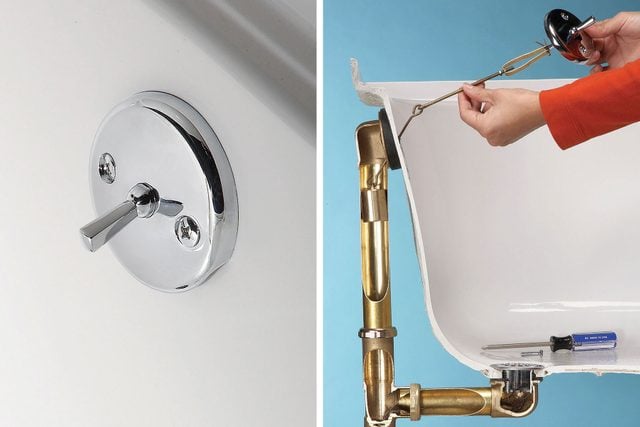
- Rocker stopper: This features a plug connected by a rod to the lever linkage. To remove the plug, lift it about an inch, then pull horizontally. This will remove the entire rocker assembly from the drain.
Use a plunger to clear standing water
Use a dome-shaped drain plunger (not a bell-shaped toilet plunger) to get standing water to drain. Fit the plunger tightly around the drain to get a good seal, then pump vigorously until the water starts draining.
Pro tip: “If you are working on a full shower and bath,” says Pittenger, “you may need to remove the overflow cover and block the hole with a towel or plastic bag to keep the suction focused on the clog.”
Clear out the hair
Use your fingers to pull any hair you can reach out of the drain. If the hair is too deep, grab any number of tools to remove it. My favorite is a Zip-It tool, a long, barbed cable tie that’s great for removing hair. It’s bendable, so you can push it deep into curved pipes.
Pittenger advises against using this tool too aggressively, however. “It can get caught or break off inside the drain and multiply your problems,” he says.
Pro tip: As an alternative, bend a hook in the end of a length of wire with needle-nose pliers and use that to snag hair. If the hair is close enough to the drain opening, you can also remove it with a jigsaw blade.
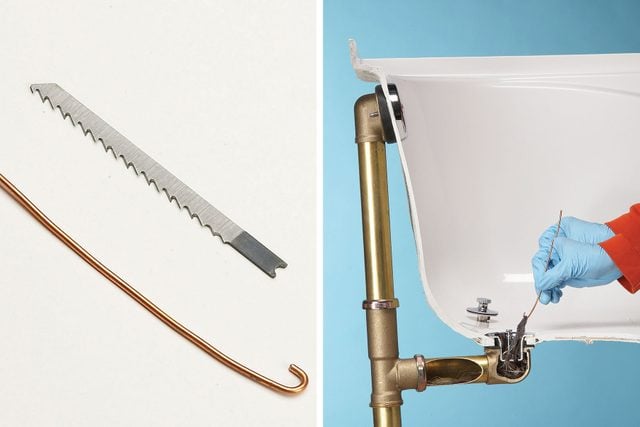
Clear deeper clogs
Use a drain auger (aka a snake) to reach clogs deeper in the pipes.
Insert the head of the auger in the drain, push until you feel resistance, crank the handle to spin the head and grab the debris, then pull the head — gunk and all — out of the drain. I usually wear gloves when doing this, and I always have a bucket ready.
Pro tip: If you have a levered or rocker stopper, Pittenger offers this tip: “If you go down the drain, there’s a tee there [where the overflow tube meets the drain]. A homeowner risks going up, not down, and getting it tied up in a knot in the overflow area.
“And if you go down through the overflow, don’t push it. Be gentle, or you risk getting the snake stuck or again, tied up in a knot. Once you’re tied up in a knot, you’re calling a plumber, who has to solve the knot problem and then clear the drain.”
Replace the stopper
To replace a drop, push/lock or rocker stopper, reverse the procedure you used to remove it. Close it and fill the tub with about an inch of water to make sure it holds. If not, make adjustments until it does.
If you removed the linkage for a levered or rocker stopper, clean hair off the plunger, drop it back into the overflow opening, screw the cover plate back on and test it.
Pro tip: Occasionally, the linkage gets out of adjustment and the stopper doesn’t open far enough from its seat to allow a good flow. Adjust it, reinsert it and run water into the tub to test it.
If it leaks out, lengthen the stopper linkage by turning the nut on the threaded rod to seal the drain better. If the drain doesn’t open to let the water out, shorten the stopper linkage by turning the nut in the opposite direction.
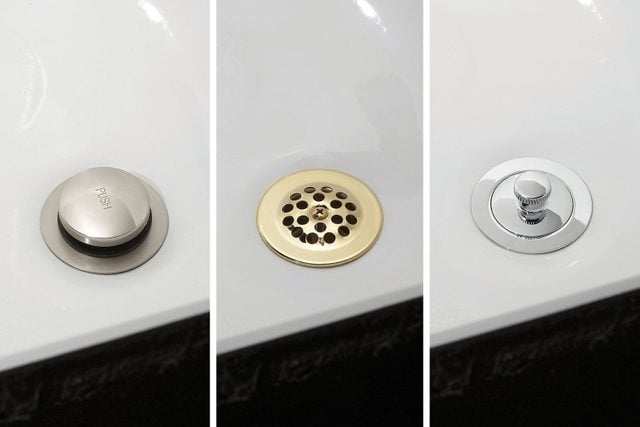
FAQs
Can you use baking soda and vinegar to unclog a drain?
Maybe. When you mix baking soda and vinegar, the combination produces a foam that’s mostly carbon dioxide. It won’t dissolve anything, but if you cover the drain and overflow hole, it may create enough mechanical force to push the clog out of the way.
Can you use Coca-Cola to unclog a drain?
Again, maybe. Phosphoric acid, one of the ingredients in Coke, can indeed dissolve a clog. However, its concentration is too small to be effective unless you leave it for a long time, and it won’t work at all if there’s standing water.
Is it OK to plunge a bathtub?
Yes. Just remember to block the overflow holes, as Pittenger recommends, to make it effective and avoid wasting your energy.
How can you prevent hair from clogging a drain?
Pittenger suggests installing a TubShroom to catch hair and prevent it from going down the drain.
“And for standing-only showers, occasionally fill up a big bucket of water and dump it down the drain,” he says. “The volume of water will help flush anything that is building up.”
About the Expert
Kyle Pittenger is a service plumber and the resident drain-cleaning expert for Service Force Plumbing. His colleagues refer to him as the “Drain Whisperer.”

